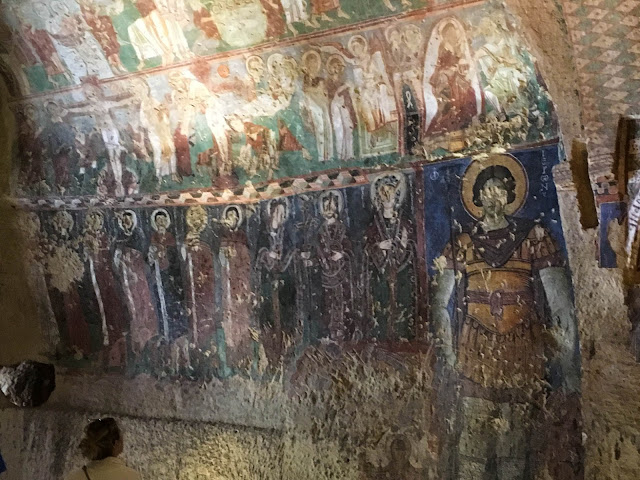 |
| The town of Goreme, Turkey where Cappadocia is. The city still uses the caves and rocks for hotels, homes, and places of business. |
 |
| A hotel in Cappadocia. |
 |
| A hotel in Cappadocia. |
 |
| Tiny stools and table for tea. |
 |
| Tourists use a stairway to see the inside of an ancient church. |
 |
| Carved rooms in the rocks. |
 |
| Entrance to a church. |
 |
| The inside of an ancient church still has brightly painted frescoes. |
 |
| Most of the eyes and faces have been scraped off the paintings. One opinion is that the Qur’an prohibits images of humans in temples, so the images were purposely destroyed. |
 |
| Looking out from a cave doorway. |
 |
| A Byzantine style cross. |
 |
| From the outside, one would never guess this was inside a cave hole. |
 |
| Rugs drying on a rooftop that overlook the city. |
 |
| A hot air balloon passes our view of the moon in the early hours of the morning. |
 |
| A tunnel of a huge underground city used by Christians in hiding from the Romans. |
 |
| Rooms of the underground city. |
 |
| Inside the underground city. |
 |
| A view of our drive through the streets of Cappadocia. |
 |
| A view of the volcano that helped create the unusual landscape of Cappadocia. Mt. Erciyes (also known as Mt. Argaeus) |
 |
| A splash of color in the monotone landscape. |
 |
| Dwellings. |
 |
| Tourists climb into the caves. |
 |
| It is said that the volcanic ash is what forms the rock underneath and the caps are made from volcanic lava which is much harder. The rock underneath erodes forming these structures. |
 |
| Natural art. |
 |
| A perspective on the size. |
 |
| Volcanic lava on top of volcanic ash rock. |
 |
| El Nazar Church |
 |
| The inside of El Nazar church |
 |
| Uchisar Castle |
 |
| Mr Erciyes - the volcano that helped form the landscape of Cappadocia. |



































































